 Pepper is a delicate southern plant, which is not easy to grow in our latitudes. With each transplant, he experiences severe stress, is sick for a long time.
Pepper is a delicate southern plant, which is not easy to grow in our latitudes. With each transplant, he experiences severe stress, is sick for a long time.
Therefore, the best choice of container for growing seedlings is peat tablets that provide maximum comfort to the roots of seedlings.
Content
Rules for choosing a container for seedlings
Each type of seedling container has its own strengths and weaknesses. Gardener care - for each type of seedlings, choose the most suitable capacity for them. Also, the choice of spring containers depends on the question whether seedlings will be transplanted for diving.
All containers for growing seedlings can be divided according to the principle of growing seedlings in them into four types:
- plastic trays and boxes;
- individual pots from a variety of material;
- peat tablets or briquettes;
- partitions trays or cassettes.
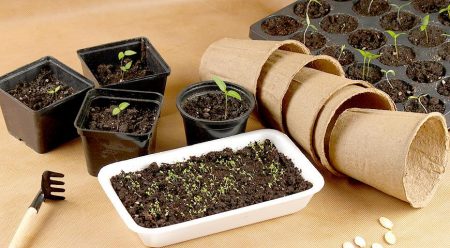
Plastic containers
Plastic containers are often used to grow pepper seedlings. They have a small mass, are easily washed and disinfected, a special form allows them to be put into each other for winter storage, dramatically saving storage space. Plastic boxes, cassettes and individual pots are available.
Plastic box
The simplest solution is a plastic box. In stores, it is now absolutely possible to choose the model of the desired volume, length and width. It is most convenient to grow seedlings in boxes 10-12 centimeters high.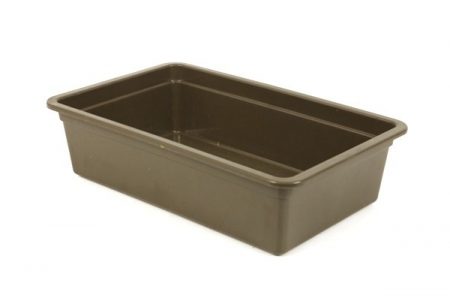
When growing seedlings in a box, all plants are grown in one volume of land.
The advantages of growing seedlings in a box:
- it is much easier to care, water and spray at the same time for all plants;
- in a box, quickly move plants to the right place or deploy at the same time all the seedlings with the right side to the sun;
- repeated use of plastic containers.
Cons of growing seedlings in a box:
- the roots of seedlings grown in one volume of land are intertwined and it is almost impossible not to damage them when planting in the ground;
- in boxes the plants grow too closely from each other;
- low boxes are not suitable for seedlings of pepper, which has a powerful vertical root;
- heavy boxes filled with earth are difficult to lift and carry.
Pots or containers
In any garden shop you can now purchase pots of any volume and color. You can choose from the smallest of 50 ml, to huge ones of ten or more liters. Pots are available in both round and square shapes.Each of them has its own positive and negative properties. Round ones are more convenient for growing seedlings, square ones are more compactly located on the windowsill, more convenient to carry.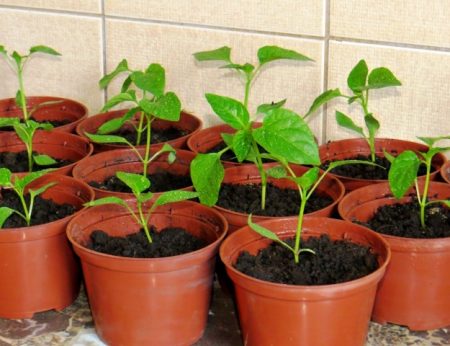
Advantages of growing seedlings in a plastic potx
- excellent root protection during transplantation;
- pots are a universal solution for any kind of seedlings;
- rarer watering seedlings due to the large amount of land for each plant;
- repeated use of plastic containers.
The disadvantages of growing seedlings in plastic pots
- to place pots (especially round ones) you need much more space on the windowsill than for boxes or containers;
- with careless extraction of an earthen coma from them, the root system of the plant can be damaged;
- it takes a lot of time to move a large number of plants.
Partition trays and cassettes
If you put partitions in a regular plastic box dividing it into many small compartments, then this design will be called a tray. If the box itself was already originally cast with partitions, then this design is called a cassette.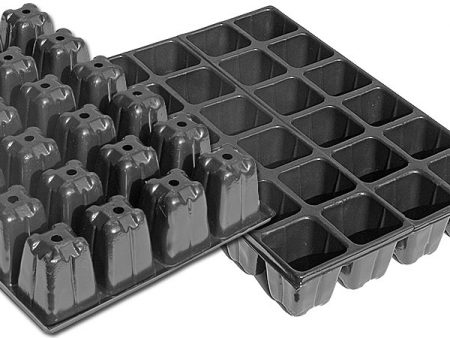
The number of cells can vary from a few pieces to several tens - it all depends on the size of the cells and the box itself.
Advantages of cassettes and trays
- the plants in the trays are very compact, they are convenient to care for;
- in cassettes it is easy to move seedlings or turn the desired side to the sun;
- several rows of cells can be cut from the molded plastic cassette to obtain the capacity of the desired external dimensions;
- repeated use of plastic containers.
Drawbacks of cassettes and trays
- a small amount of earth is placed in individual cells of the cassettes, so the plant located there requires more frequent watering;
- cassettes are made of thin plastic; if handled carelessly they break;
- shallow cassettes are absolutely not suitable for growing pepper seedlings with a powerful vertical root;
- it is quite problematic to pull out a separate plant from a tray or cassette without damaging its root system;
- cassettes filled with earth with a large number of cells are difficult to carry from place to place.
Paper containers
A very convenient option for growing seedlings is disposable paper cassettes. They are made of pressed cardboard, have a different size. In spring, they are filled with soil, then seedlings are grown, and then young seedlings are planted directly in honeycombs in the soil. Under the influence of water, the paper shell is destroyed, and the roots go outside.
The advantages of paper cassettes
- the most careful handling of the root system of seedlings during their planting in the ground;
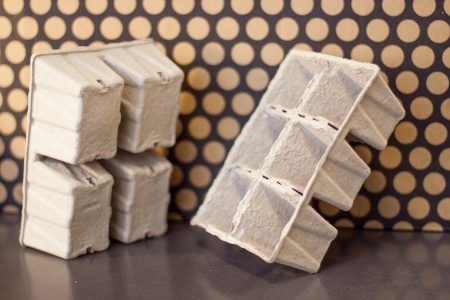
- the plants in the trays are very compact, they are convenient to care for;
- in cassettes it is easy to move seedlings or turn the desired side to the sun;
- several rows of cells can be cut from the molded paper cassette to produce containers of the desired external dimensions;
- paper - vapor and breathable material. The soil in a container with paper walls is better saturated with oxygen, the root system of seedlings develops better;
- low cost of cartridges.
Disadvantages of paper cassettes
- with active irrigation, the paper walls of the cassettes can get wet and collapse;
- shallow cassettes are absolutely not suitable for growing pepper seedlings with a powerful vertical root;
- on wet paper, different molds may begin to develop;
- for use on a windowsill, paper trays require a plastic tray.
Peat containers
Currently, containers for seedlings from natural environmentally friendly peat material are widely used. Two types of seedlings are available - pots and tablets.
Peat pots
Peat pots are a more modern version of paper containers for seedlings. They are made 3/4 of peat and 1/4 of pressed cardboard.Variants of execution are very diverse - from small-mesh cassettes to quite solid pots.
Before planting pepper seeds, containers should be filled with garden soil. In spring, seedlings are planted together with pots, which, under the influence of soil moisture, soak and dissolve in the soil.
The advantages of peat pots
- low cost;
- peat is a vapor- and breathable material. The soil in a container with peat walls is better saturated with oxygen, the root system of seedlings develops better;
- the most careful handling of the root system of seedlings during their planting in the ground.
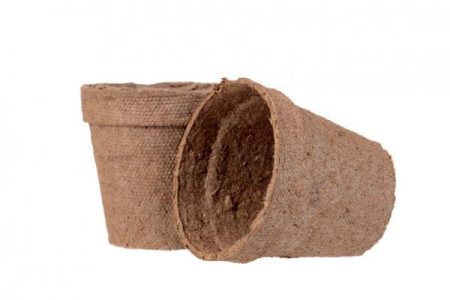
The disadvantages of peat pots
- with regular wetting, peat pots have a limited service life;
- peat pots evaporate moisture along the entire lateral surface, so the number of waterings should be increased;
- with excess moisture, the walls of the containers may become moldy.
Peat pills
Peat tablets have recently appeared in the arsenal of gardeners. They look like a low brown cylinder wrapped in plastic mesh. These cylinders are available in diameters from 2.5 to 9 centimeters.
Before use, the tablets are saturated with moisture, placed in a tray with water. At the same time, their height increases 5 times.
The benefits of peat tablets
- acquiring peat tablets, the gardener gets rid of the problem of acquiring soil - inside the peat shell there is a full-fledged substrate for growing seedlings;
- peat is a vapor- and breathable material. The soil in a pot with peat walls is better saturated with oxygen, the root system of seedlings develops better;
- high tablets of large diameter are an excellent option for growing pepper seedlings with its powerful core root;
- the most careful handling of the root system of seedlings during their planting in the ground.
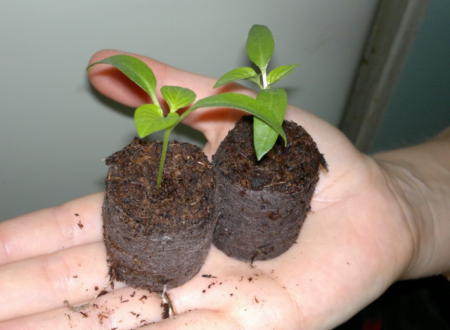
Disadvantages of Peat Pills
- the cost of the tablets is quite high, but they are used only once;
- soil moisture when growing seedlings in these containers requires careful monitoring. With regular waterlogging, the tablets can crumble, if the soil dries, the plant will die.
Pepper seedlings growing in peat tablets
Seeds for growing pepper seedlings in peat tablets begin to be prepared in the first decade of March. Before germination, the seeds are disinfected by immersing for 20 minutes in a solution of potassium permanganate. After that, they are wrapped in a damp cloth and placed for a week in a warm place. The optimum temperature for seed germination plus twenty-five degrees Celsius.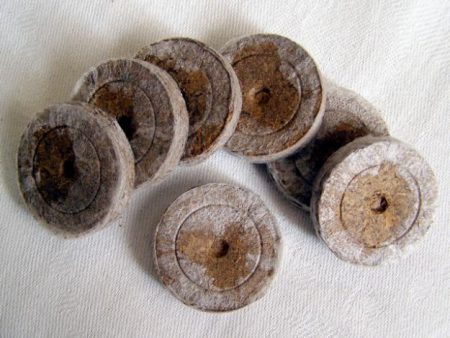
Before planting, the required number of tablets is placed in a tray and filled with warm water. As it is absorbed, water is periodically added until the tablets swell to the required height.
At the top of the peat column, they make a recess of one and a half centimeters, in which with the help of tweezers they place the peeled seed of pepper. Top recess is filled with planting soil. The tablets are wrapped in polyethylene and left for a week until emergence.
After about a decade, the film is removed, and a tray with peat tablets is placed in a bright place. The optimum temperature for the development of seedlings during this period is plus twenty-five degrees Celsius during the day and plus fifteen degrees at night.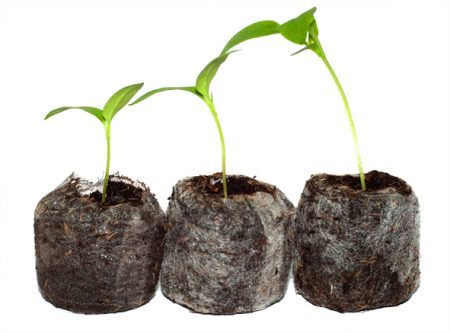
During the cultivation of seedlings in peat tablets, pepper is not required to be fed, since all the substances required for development are contained in peat soil. Watering seedlings grown in peat tablets is not often required; a sign of lack of moisture will be a decrease in the height of the peat column. After restoring the height, the remaining water in the pan is drained.
When transplanting pepper into the ground, the net from the peat tablet is carefully cut.
Homemade containers
Wooden seedling boxes
Boxes for seedlings can be independently put together from wood or multilayer plywood. After manufacturing, the box is impregnated with decay with drying oil and painted with paint. Before use, a film or oilcloth is laid inside. The advantages of this design are the ability to produce a container that is ideally suited for the size of the window sill and low cost. Minus - much more weight relative to plastic.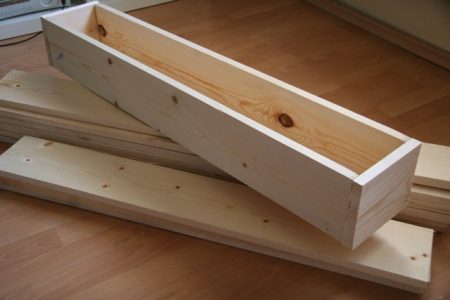
Homemade Disposable Cup Pots
From the disposable cups remaining after the picnic, you can make convenient pots for growing seedlings. To do this, make holes in the bottom with a hot awl or nail in the bottom to drain excess water. In 100 ml cups it is convenient to grow seedlings before diving, and in a volume of 500 ml seedlings are grown before planting in the ground.
Tetrapack Pots
Convenient containers for seedlings can be made from rectangular tetrapacks from milk, wine or juice. To do this, they are cut to the desired height, washed thoroughly, drainage holes are made in the bottom.
Pots of plastic bottles
Convenient containers can be made from soda, water or beer bottles. To do this, they are cut off, drainage holes are made in the bottom.
There is also the option of cutting off the top and bottom of the bottle so that a plastic cylinder remains. So that the earth does not spill out from the open bottom, it is installed on a pallet before stuffing with soil and kept on the pallet all the time seedlings are grown.
Eggshell Containers
The eggshell can be adapted for growing seedlings of small plants. To do this, during cooking, the tip is carefully broken at the egg, the contents are poured out, and the egg itself is disinfected with boiling water. The opposite end of the shell is carefully pricked with a needle.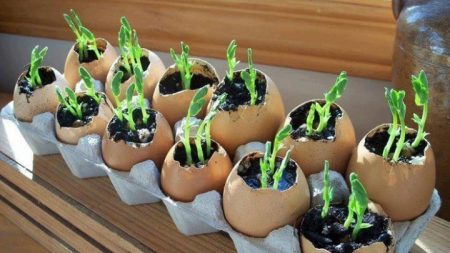
Before planting, the shells are installed in egg containers and filled with earth. All the time the seedlings will grow, they will receive calcium, washed off the walls of such a pot, and therefore grow strong.
When landing in the ground, the egg is crushed in the hand, and a lump of earth with roots is planted. Egg shells not only enrich the soil with useful minerals, but also further reduce the acidity of the soil.
Paper pots
For the manufacture of paper landing containers, take any round bottle and wrap it in several layers with a newspaper. The edge of the paper is fixed with a strip of glue. At the bottom, the newspaper is bent and also fixed with glue. Before filling the ground, the cups are placed on a pallet. When planting in the ground, the paper is torn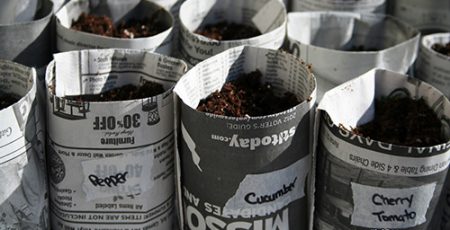
The second option for making pots. The bottle is wrapped in several layers of toilet paper. Then the paper is wetted with water from the spray gun and it remains to dry on the form. After drying, a cardboard cylinder of the desired diameter is obtained.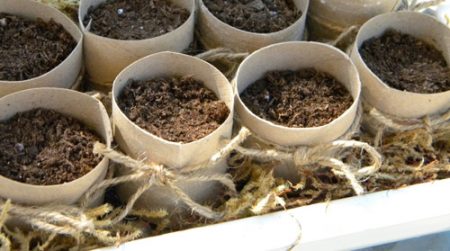
Note: As seedling containers, you can use coils on which toilet paper is wound.
Pots made of polyethylene
Sufficiently budget option to use as containers of plastic bags made from milk or kefir. To do this, they are washed, holes are made in the bottom of the package, filled with earth and put in a box. When planting, the polyethylene is either torn, or a lump of earth with roots is carefully pulled out of it.
The second option is the use of polyethylene. In this case, the bottle is wrapped with thick polyethylene, the edges of the film are fixed either with a clerical stapler or welded with a soldering iron. The resulting cylinders are mounted on a pallet and then stuffed with earth.
Nonwoven Pots
To make pots, they take a black dense spunbond with a density of 120 g / m, a bag is sewn according to the pattern. Non-woven material perfectly saturates the soil with air and passes excess moisture through it.
Output
The choice of containers for growing seedlings is wide enough.The task of the gardener is to choose the capacity that is most convenient for both the plant for growth and the plant grower for serving the spring garden on the windowsill.
https://youtu.be/cCt82o0KG7Y
Reviews
Elena, 38 years old
We use half-liter beer glasses for planting seedlings of peppers. Packing 50 pieces comes out fairly budget. After planting the seeds, put the glasses in a transparent Ikeevsky container and close the lid on top. It turns out on the window mini-greenhouse. Seedlings are growing just great!
Tatyana, 42 years old
Peppers are our choice when growing peppers. Yes, it’s not very cheap, but it nourished them with moisture and you don’t have to worry about quality, soil composition, or top dressing. Maximum convenience and minimum worries!




 Calorie pepper stuffed with meat and rice - BZHU per 100 grams
Calorie pepper stuffed with meat and rice - BZHU per 100 grams Gorky pepper - the best varieties for open ground
Gorky pepper - the best varieties for open ground Hot pepper seeds - the best varieties for open ground and reviews
Hot pepper seeds - the best varieties for open ground and reviews Capsicum tincture for hair - how to use and reviews
Capsicum tincture for hair - how to use and reviews